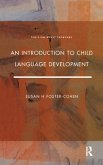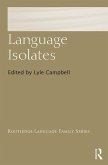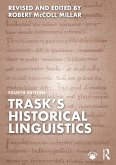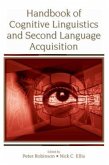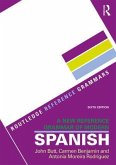Chenlei Zhou
Zhoutun
Chenlei Zhou
Zhoutun
- Broschiertes Buch
- Merkliste
- Auf die Merkliste
- Bewerten Bewerten
- Teilen
- Produkt teilen
- Produkterinnerung
- Produkterinnerung
This book presents a description of the grammar of Zhoutun, an endangered Sinitic variety spoken by less than 1000 people in the Qinghai Province of northwest China. With vocabulary predominantly from Chinese and Tibetan syntax, Zhoutun is one of the Sinitic varieties most distant from Standard Chinese.
Andere Kunden interessierten sich auch für
![Zhoutun Zhoutun]() Chenlei ZhouZhoutun54,99 €
Chenlei ZhouZhoutun54,99 €![An Introduction to Child Language Development An Introduction to Child Language Development]() Susan H.Foster- CohenAn Introduction to Child Language Development152,99 €
Susan H.Foster- CohenAn Introduction to Child Language Development152,99 €![Nantong Chinese Nantong Chinese]() Benjamin AoNantong Chinese45,99 €
Benjamin AoNantong Chinese45,99 €![Language Isolates Language Isolates]() Language Isolates262,99 €
Language Isolates262,99 €![Trask's Historical Linguistics Trask's Historical Linguistics]() Robert McColl MillarTrask's Historical Linguistics38,99 €
Robert McColl MillarTrask's Historical Linguistics38,99 €![Handbook of Cognitive Linguistics and Second Language Acquisition Handbook of Cognitive Linguistics and Second Language Acquisition]() Handbook of Cognitive Linguistics and Second Language Acquisition94,99 €
Handbook of Cognitive Linguistics and Second Language Acquisition94,99 €![A New Reference Grammar of Modern Spanish A New Reference Grammar of Modern Spanish]() John Butt (UK Kings College London)A New Reference Grammar of Modern Spanish66,99 €
John Butt (UK Kings College London)A New Reference Grammar of Modern Spanish66,99 €-
-
-
This book presents a description of the grammar of Zhoutun, an endangered Sinitic variety spoken by less than 1000 people in the Qinghai Province of northwest China. With vocabulary predominantly from Chinese and Tibetan syntax, Zhoutun is one of the Sinitic varieties most distant from Standard Chinese.
Hinweis: Dieser Artikel kann nur an eine deutsche Lieferadresse ausgeliefert werden.
Hinweis: Dieser Artikel kann nur an eine deutsche Lieferadresse ausgeliefert werden.
Produktdetails
- Produktdetails
- Routledge World Languages
- Verlag: Taylor & Francis Ltd
- Seitenzahl: 178
- Erscheinungstermin: 29. Januar 2024
- Englisch
- Abmessung: 216mm x 140mm x 10mm
- Gewicht: 228g
- ISBN-13: 9781032113180
- ISBN-10: 1032113189
- Artikelnr.: 69790696
- Herstellerkennzeichnung
- Libri GmbH
- Europaallee 1
- 36244 Bad Hersfeld
- gpsr@libri.de
- Routledge World Languages
- Verlag: Taylor & Francis Ltd
- Seitenzahl: 178
- Erscheinungstermin: 29. Januar 2024
- Englisch
- Abmessung: 216mm x 140mm x 10mm
- Gewicht: 228g
- ISBN-13: 9781032113180
- ISBN-10: 1032113189
- Artikelnr.: 69790696
- Herstellerkennzeichnung
- Libri GmbH
- Europaallee 1
- 36244 Bad Hersfeld
- gpsr@libri.de
Chenlei Zhou is an associate professor at the Institute of Linguistics, Chinese Academy of Social Sciences. His main research interests are linguistic typology, language contact and Chinese grammar, and he has published more than 20 articles in journals such as Lingua; Language and Linguistics; and the Journal of Chinese Linguistics.
Contents Dedication Contents Chapter 1: Introduction Chapter 2: Phonology Chapter 3: Nouns and noun phrases 3.1 Definition 3.2 Word formation 3.2.1 Affixation 3.2.2 Reduplication 3.2.3 Compounding 3.3 Number 3.3.1 =m
3.3.2 =li
3.4 Case relations 3.4.1 Dative-accusative =xa/=a 3.4.2 Comitative-instrumental =laÞ 3.4.3 Ablative =tha 3.4.4 Locative =li and =x
Þ 3.4.5 Genitive =t
3.4.6 Comparative khaÞ 3.5 Referentiality 3.5.1 Generic 3.5.2 Individual Chapter 4: Verbs and verb phrases 4.1 Definition 4.2 Aspect 4.2.1 Perfective 4.2.2 Future 4.2.3 Ingressive 4.2.4 Progressive 4.2.5 Resultative 4.2.6 Experiential 4.2.7 The expression of tense 4.3 Modality 4.3.1 Dynamic modality 4.3.2 Epistemic modality 4.3.3 Deontic modality 4.3.4 Evidentiality 4.3.5 Negation 4.4 Serial verb construction 4.5 Verb-complement constructions 4.5.1 Verb-direction constructions 4.5.2 Verb-result construction 4.5.3 Verb-degree construction 4.6 Valance changing 4.7 Possession and Existence Chapter 5: Adjectives and adverbs 5.1 Adjectives 5.1.1 Identify adjectives and verbs 5.1.2 Adjectives as modifiers 5.1.3 Adjectives as predicates 5.2 Adverbs 5.2.1 Position 5.2.2 Some common adverbs 5.2.3 Reduplication Chapter 6: Minor word classes 6.1 Pronoun 6.1.1 First person 6.1.2 Second person 6.1.3 Third person 6.1.4 Reflexive 6.1.5 Locutor-referential 6.2 Demonstratives 6.2.1 The system 6.2.2 Animate and inanimate referents 6.2.3 Location referents 6.2.4 Manner and degree 6.3 Interrogative words 6.3.1 tü-words 6.3.2 a- words 6.3.3 -m
words 6.3.4 Others 6.4 Numerals 6.4.1 Cardinal and ordinal numerals 6.4.2 Fractional numerals 6.5 Classifiers 6.5.1 Nominal classifiers 6.5.2 Verbal classifiers 6.5.3 The position of Num+CL and noun 6.6 Final particles 6.6.1 ti 6.6.2 pa 6.6.3 li 6.6.4 xüÞ 6.6.5 k
6.6.6 ta 6.6.7 ia 6.6.8 m
6.6.9 p
6.6.10 sa 6.6.11 Summary 6.7 Adpositions 6.7.1 Prepositions 6.7.2 Postpositions 6.8 Coordinators 6.8.1 Conjunctive coordinator 6.8.2 Disjunctive coordinators Chapter 7: Clause structure 7.1 Word order 7.2 Ditransitive construction 7.3 Copula clause 7.4 Comparative clause 7.4.1 Comparative construction 7.4.2 Comparative construction of equality 7.4.3 Superlative construction 7.5 Imperative clause 7.5.1 The form of imperative clauses 7.5.2 The negation of imperative clause 7.6 Interrogative clause 7.6.1 Yes-no question 7.6.2 Wh-question 7.6.3 Alternative question 7.6.4 Tag question 7.7 Subordinate clause 7.7.1 Relative clause 7.7.2 Complement clause 7.7.3 Adverbial clause 7.8 Topic structure References Appendix I. Narrative: The past life in Zhoutun II. List of abbreviations
3.3.2 =li
3.4 Case relations 3.4.1 Dative-accusative =xa/=a 3.4.2 Comitative-instrumental =laÞ 3.4.3 Ablative =tha 3.4.4 Locative =li and =x
Þ 3.4.5 Genitive =t
3.4.6 Comparative khaÞ 3.5 Referentiality 3.5.1 Generic 3.5.2 Individual Chapter 4: Verbs and verb phrases 4.1 Definition 4.2 Aspect 4.2.1 Perfective 4.2.2 Future 4.2.3 Ingressive 4.2.4 Progressive 4.2.5 Resultative 4.2.6 Experiential 4.2.7 The expression of tense 4.3 Modality 4.3.1 Dynamic modality 4.3.2 Epistemic modality 4.3.3 Deontic modality 4.3.4 Evidentiality 4.3.5 Negation 4.4 Serial verb construction 4.5 Verb-complement constructions 4.5.1 Verb-direction constructions 4.5.2 Verb-result construction 4.5.3 Verb-degree construction 4.6 Valance changing 4.7 Possession and Existence Chapter 5: Adjectives and adverbs 5.1 Adjectives 5.1.1 Identify adjectives and verbs 5.1.2 Adjectives as modifiers 5.1.3 Adjectives as predicates 5.2 Adverbs 5.2.1 Position 5.2.2 Some common adverbs 5.2.3 Reduplication Chapter 6: Minor word classes 6.1 Pronoun 6.1.1 First person 6.1.2 Second person 6.1.3 Third person 6.1.4 Reflexive 6.1.5 Locutor-referential 6.2 Demonstratives 6.2.1 The system 6.2.2 Animate and inanimate referents 6.2.3 Location referents 6.2.4 Manner and degree 6.3 Interrogative words 6.3.1 tü-words 6.3.2 a- words 6.3.3 -m
words 6.3.4 Others 6.4 Numerals 6.4.1 Cardinal and ordinal numerals 6.4.2 Fractional numerals 6.5 Classifiers 6.5.1 Nominal classifiers 6.5.2 Verbal classifiers 6.5.3 The position of Num+CL and noun 6.6 Final particles 6.6.1 ti 6.6.2 pa 6.6.3 li 6.6.4 xüÞ 6.6.5 k
6.6.6 ta 6.6.7 ia 6.6.8 m
6.6.9 p
6.6.10 sa 6.6.11 Summary 6.7 Adpositions 6.7.1 Prepositions 6.7.2 Postpositions 6.8 Coordinators 6.8.1 Conjunctive coordinator 6.8.2 Disjunctive coordinators Chapter 7: Clause structure 7.1 Word order 7.2 Ditransitive construction 7.3 Copula clause 7.4 Comparative clause 7.4.1 Comparative construction 7.4.2 Comparative construction of equality 7.4.3 Superlative construction 7.5 Imperative clause 7.5.1 The form of imperative clauses 7.5.2 The negation of imperative clause 7.6 Interrogative clause 7.6.1 Yes-no question 7.6.2 Wh-question 7.6.3 Alternative question 7.6.4 Tag question 7.7 Subordinate clause 7.7.1 Relative clause 7.7.2 Complement clause 7.7.3 Adverbial clause 7.8 Topic structure References Appendix I. Narrative: The past life in Zhoutun II. List of abbreviations
Contents
Dedication
Contents
Chapter 1: Introduction
Chapter 2: Phonology
Chapter 3: Nouns and noun phrases
3.1 Definition
3.2 Word formation
3.2.1 Affixation
3.2.2 Reduplication
3.2.3 Compounding
3.3 Number
3.3.1 =m
3.3.2 =li
3.4 Case relations
3.4.1 Dative-accusative =xa/=a
3.4.2 Comitative-instrumental =laÞ
3.4.3 Ablative =tha
3.4.4 Locative =li and =x Þ
3.4.5 Genitive =t
3.4.6 Comparative khaÞ
3.5 Referentiality
3.5.1 Generic
3.5.2 Individual
Chapter 4: Verbs and verb phrases
4.1 Definition
4.2 Aspect
4.2.1 Perfective
4.2.2 Future
4.2.3 Ingressive
4.2.4 Progressive
4.2.5 Resultative
4.2.6 Experiential
4.2.7 The expression of tense
4.3 Modality
4.3.1 Dynamic modality
4.3.2 Epistemic modality
4.3.3 Deontic modality
4.3.4 Evidentiality
4.3.5 Negation
4.4 Serial verb construction
4.5 Verb-complement constructions
4.5.1 Verb-direction constructions
4.5.2 Verb-result construction
4.5.3 Verb-degree construction
4.6 Valance changing
4.7 Possession and Existence
Chapter 5: Adjectives and adverbs
5.1 Adjectives
5.1.1 Identify adjectives and verbs
5.1.2 Adjectives as modifiers
5.1.3 Adjectives as predicates
5.2 Adverbs
5.2.1 Position
5.2.2 Some common adverbs
5.2.3 Reduplication
Chapter 6: Minor word classes
6.1 Pronoun
6.1.1 First person
6.1.2 Second person
6.1.3 Third person
6.1.4 Reflexive
6.1.5 Locutor-referential
6.2 Demonstratives
6.2.1 The system
6.2.2 Animate and inanimate referents
6.2.3 Location referents
6.2.4 Manner and degree
6.3 Interrogative words
6.3.1 tu -words
6.3.2 a- words
6.3.3 -m words
6.3.4 Others
6.4 Numerals
6.4.1 Cardinal and ordinal numerals
6.4.2 Fractional numerals
6.5 Classifiers
6.5.1 Nominal classifiers
6.5.2 Verbal classifiers
6.5.3 The position of Num+CL and noun
6.6 Final particles
6.6.1 ti
6.6.2 pa
6.6.3 li
6.6.4 xu Þ
6.6.5 k
6.6.6 ta
6.6.7 ia
6.6.8 m
6.6.9 p
6.6.10 sa
6.6.11 Summary
6.7 Adpositions
6.7.1 Prepositions
6.7.2 Postpositions
6.8 Coordinators
6.8.1 Conjunctive coordinator
6.8.2 Disjunctive coordinators
Chapter 7: Clause structure
7.1 Word order
7.2 Ditransitive construction
7.3 Copula clause
7.4 Comparative clause
7.4.1 Comparative construction
7.4.2 Comparative construction of equality
7.4.3 Superlative construction
7.5 Imperative clause
7.5.1 The form of imperative clauses
7.5.2 The negation of imperative clause
7.6 Interrogative clause
7.6.1 Yes-no question
7.6.2 Wh-question
7.6.3 Alternative question
7.6.4 Tag question
7.7 Subordinate clause
7.7.1 Relative clause
7.7.2 Complement clause
7.7.3 Adverbial clause
7.8 Topic structure
References
Appendix
I. Narrative: The past life in Zhoutun
II. List of abbreviations
Dedication
Contents
Chapter 1: Introduction
Chapter 2: Phonology
Chapter 3: Nouns and noun phrases
3.1 Definition
3.2 Word formation
3.2.1 Affixation
3.2.2 Reduplication
3.2.3 Compounding
3.3 Number
3.3.1 =m
3.3.2 =li
3.4 Case relations
3.4.1 Dative-accusative =xa/=a
3.4.2 Comitative-instrumental =laÞ
3.4.3 Ablative =tha
3.4.4 Locative =li and =x Þ
3.4.5 Genitive =t
3.4.6 Comparative khaÞ
3.5 Referentiality
3.5.1 Generic
3.5.2 Individual
Chapter 4: Verbs and verb phrases
4.1 Definition
4.2 Aspect
4.2.1 Perfective
4.2.2 Future
4.2.3 Ingressive
4.2.4 Progressive
4.2.5 Resultative
4.2.6 Experiential
4.2.7 The expression of tense
4.3 Modality
4.3.1 Dynamic modality
4.3.2 Epistemic modality
4.3.3 Deontic modality
4.3.4 Evidentiality
4.3.5 Negation
4.4 Serial verb construction
4.5 Verb-complement constructions
4.5.1 Verb-direction constructions
4.5.2 Verb-result construction
4.5.3 Verb-degree construction
4.6 Valance changing
4.7 Possession and Existence
Chapter 5: Adjectives and adverbs
5.1 Adjectives
5.1.1 Identify adjectives and verbs
5.1.2 Adjectives as modifiers
5.1.3 Adjectives as predicates
5.2 Adverbs
5.2.1 Position
5.2.2 Some common adverbs
5.2.3 Reduplication
Chapter 6: Minor word classes
6.1 Pronoun
6.1.1 First person
6.1.2 Second person
6.1.3 Third person
6.1.4 Reflexive
6.1.5 Locutor-referential
6.2 Demonstratives
6.2.1 The system
6.2.2 Animate and inanimate referents
6.2.3 Location referents
6.2.4 Manner and degree
6.3 Interrogative words
6.3.1 tu -words
6.3.2 a- words
6.3.3 -m words
6.3.4 Others
6.4 Numerals
6.4.1 Cardinal and ordinal numerals
6.4.2 Fractional numerals
6.5 Classifiers
6.5.1 Nominal classifiers
6.5.2 Verbal classifiers
6.5.3 The position of Num+CL and noun
6.6 Final particles
6.6.1 ti
6.6.2 pa
6.6.3 li
6.6.4 xu Þ
6.6.5 k
6.6.6 ta
6.6.7 ia
6.6.8 m
6.6.9 p
6.6.10 sa
6.6.11 Summary
6.7 Adpositions
6.7.1 Prepositions
6.7.2 Postpositions
6.8 Coordinators
6.8.1 Conjunctive coordinator
6.8.2 Disjunctive coordinators
Chapter 7: Clause structure
7.1 Word order
7.2 Ditransitive construction
7.3 Copula clause
7.4 Comparative clause
7.4.1 Comparative construction
7.4.2 Comparative construction of equality
7.4.3 Superlative construction
7.5 Imperative clause
7.5.1 The form of imperative clauses
7.5.2 The negation of imperative clause
7.6 Interrogative clause
7.6.1 Yes-no question
7.6.2 Wh-question
7.6.3 Alternative question
7.6.4 Tag question
7.7 Subordinate clause
7.7.1 Relative clause
7.7.2 Complement clause
7.7.3 Adverbial clause
7.8 Topic structure
References
Appendix
I. Narrative: The past life in Zhoutun
II. List of abbreviations
Contents Dedication Contents Chapter 1: Introduction Chapter 2: Phonology Chapter 3: Nouns and noun phrases 3.1 Definition 3.2 Word formation 3.2.1 Affixation 3.2.2 Reduplication 3.2.3 Compounding 3.3 Number 3.3.1 =m
3.3.2 =li
3.4 Case relations 3.4.1 Dative-accusative =xa/=a 3.4.2 Comitative-instrumental =laÞ 3.4.3 Ablative =tha 3.4.4 Locative =li and =x
Þ 3.4.5 Genitive =t
3.4.6 Comparative khaÞ 3.5 Referentiality 3.5.1 Generic 3.5.2 Individual Chapter 4: Verbs and verb phrases 4.1 Definition 4.2 Aspect 4.2.1 Perfective 4.2.2 Future 4.2.3 Ingressive 4.2.4 Progressive 4.2.5 Resultative 4.2.6 Experiential 4.2.7 The expression of tense 4.3 Modality 4.3.1 Dynamic modality 4.3.2 Epistemic modality 4.3.3 Deontic modality 4.3.4 Evidentiality 4.3.5 Negation 4.4 Serial verb construction 4.5 Verb-complement constructions 4.5.1 Verb-direction constructions 4.5.2 Verb-result construction 4.5.3 Verb-degree construction 4.6 Valance changing 4.7 Possession and Existence Chapter 5: Adjectives and adverbs 5.1 Adjectives 5.1.1 Identify adjectives and verbs 5.1.2 Adjectives as modifiers 5.1.3 Adjectives as predicates 5.2 Adverbs 5.2.1 Position 5.2.2 Some common adverbs 5.2.3 Reduplication Chapter 6: Minor word classes 6.1 Pronoun 6.1.1 First person 6.1.2 Second person 6.1.3 Third person 6.1.4 Reflexive 6.1.5 Locutor-referential 6.2 Demonstratives 6.2.1 The system 6.2.2 Animate and inanimate referents 6.2.3 Location referents 6.2.4 Manner and degree 6.3 Interrogative words 6.3.1 tü-words 6.3.2 a- words 6.3.3 -m
words 6.3.4 Others 6.4 Numerals 6.4.1 Cardinal and ordinal numerals 6.4.2 Fractional numerals 6.5 Classifiers 6.5.1 Nominal classifiers 6.5.2 Verbal classifiers 6.5.3 The position of Num+CL and noun 6.6 Final particles 6.6.1 ti 6.6.2 pa 6.6.3 li 6.6.4 xüÞ 6.6.5 k
6.6.6 ta 6.6.7 ia 6.6.8 m
6.6.9 p
6.6.10 sa 6.6.11 Summary 6.7 Adpositions 6.7.1 Prepositions 6.7.2 Postpositions 6.8 Coordinators 6.8.1 Conjunctive coordinator 6.8.2 Disjunctive coordinators Chapter 7: Clause structure 7.1 Word order 7.2 Ditransitive construction 7.3 Copula clause 7.4 Comparative clause 7.4.1 Comparative construction 7.4.2 Comparative construction of equality 7.4.3 Superlative construction 7.5 Imperative clause 7.5.1 The form of imperative clauses 7.5.2 The negation of imperative clause 7.6 Interrogative clause 7.6.1 Yes-no question 7.6.2 Wh-question 7.6.3 Alternative question 7.6.4 Tag question 7.7 Subordinate clause 7.7.1 Relative clause 7.7.2 Complement clause 7.7.3 Adverbial clause 7.8 Topic structure References Appendix I. Narrative: The past life in Zhoutun II. List of abbreviations
3.3.2 =li
3.4 Case relations 3.4.1 Dative-accusative =xa/=a 3.4.2 Comitative-instrumental =laÞ 3.4.3 Ablative =tha 3.4.4 Locative =li and =x
Þ 3.4.5 Genitive =t
3.4.6 Comparative khaÞ 3.5 Referentiality 3.5.1 Generic 3.5.2 Individual Chapter 4: Verbs and verb phrases 4.1 Definition 4.2 Aspect 4.2.1 Perfective 4.2.2 Future 4.2.3 Ingressive 4.2.4 Progressive 4.2.5 Resultative 4.2.6 Experiential 4.2.7 The expression of tense 4.3 Modality 4.3.1 Dynamic modality 4.3.2 Epistemic modality 4.3.3 Deontic modality 4.3.4 Evidentiality 4.3.5 Negation 4.4 Serial verb construction 4.5 Verb-complement constructions 4.5.1 Verb-direction constructions 4.5.2 Verb-result construction 4.5.3 Verb-degree construction 4.6 Valance changing 4.7 Possession and Existence Chapter 5: Adjectives and adverbs 5.1 Adjectives 5.1.1 Identify adjectives and verbs 5.1.2 Adjectives as modifiers 5.1.3 Adjectives as predicates 5.2 Adverbs 5.2.1 Position 5.2.2 Some common adverbs 5.2.3 Reduplication Chapter 6: Minor word classes 6.1 Pronoun 6.1.1 First person 6.1.2 Second person 6.1.3 Third person 6.1.4 Reflexive 6.1.5 Locutor-referential 6.2 Demonstratives 6.2.1 The system 6.2.2 Animate and inanimate referents 6.2.3 Location referents 6.2.4 Manner and degree 6.3 Interrogative words 6.3.1 tü-words 6.3.2 a- words 6.3.3 -m
words 6.3.4 Others 6.4 Numerals 6.4.1 Cardinal and ordinal numerals 6.4.2 Fractional numerals 6.5 Classifiers 6.5.1 Nominal classifiers 6.5.2 Verbal classifiers 6.5.3 The position of Num+CL and noun 6.6 Final particles 6.6.1 ti 6.6.2 pa 6.6.3 li 6.6.4 xüÞ 6.6.5 k
6.6.6 ta 6.6.7 ia 6.6.8 m
6.6.9 p
6.6.10 sa 6.6.11 Summary 6.7 Adpositions 6.7.1 Prepositions 6.7.2 Postpositions 6.8 Coordinators 6.8.1 Conjunctive coordinator 6.8.2 Disjunctive coordinators Chapter 7: Clause structure 7.1 Word order 7.2 Ditransitive construction 7.3 Copula clause 7.4 Comparative clause 7.4.1 Comparative construction 7.4.2 Comparative construction of equality 7.4.3 Superlative construction 7.5 Imperative clause 7.5.1 The form of imperative clauses 7.5.2 The negation of imperative clause 7.6 Interrogative clause 7.6.1 Yes-no question 7.6.2 Wh-question 7.6.3 Alternative question 7.6.4 Tag question 7.7 Subordinate clause 7.7.1 Relative clause 7.7.2 Complement clause 7.7.3 Adverbial clause 7.8 Topic structure References Appendix I. Narrative: The past life in Zhoutun II. List of abbreviations
Contents
Dedication
Contents
Chapter 1: Introduction
Chapter 2: Phonology
Chapter 3: Nouns and noun phrases
3.1 Definition
3.2 Word formation
3.2.1 Affixation
3.2.2 Reduplication
3.2.3 Compounding
3.3 Number
3.3.1 =m
3.3.2 =li
3.4 Case relations
3.4.1 Dative-accusative =xa/=a
3.4.2 Comitative-instrumental =laÞ
3.4.3 Ablative =tha
3.4.4 Locative =li and =x Þ
3.4.5 Genitive =t
3.4.6 Comparative khaÞ
3.5 Referentiality
3.5.1 Generic
3.5.2 Individual
Chapter 4: Verbs and verb phrases
4.1 Definition
4.2 Aspect
4.2.1 Perfective
4.2.2 Future
4.2.3 Ingressive
4.2.4 Progressive
4.2.5 Resultative
4.2.6 Experiential
4.2.7 The expression of tense
4.3 Modality
4.3.1 Dynamic modality
4.3.2 Epistemic modality
4.3.3 Deontic modality
4.3.4 Evidentiality
4.3.5 Negation
4.4 Serial verb construction
4.5 Verb-complement constructions
4.5.1 Verb-direction constructions
4.5.2 Verb-result construction
4.5.3 Verb-degree construction
4.6 Valance changing
4.7 Possession and Existence
Chapter 5: Adjectives and adverbs
5.1 Adjectives
5.1.1 Identify adjectives and verbs
5.1.2 Adjectives as modifiers
5.1.3 Adjectives as predicates
5.2 Adverbs
5.2.1 Position
5.2.2 Some common adverbs
5.2.3 Reduplication
Chapter 6: Minor word classes
6.1 Pronoun
6.1.1 First person
6.1.2 Second person
6.1.3 Third person
6.1.4 Reflexive
6.1.5 Locutor-referential
6.2 Demonstratives
6.2.1 The system
6.2.2 Animate and inanimate referents
6.2.3 Location referents
6.2.4 Manner and degree
6.3 Interrogative words
6.3.1 tu -words
6.3.2 a- words
6.3.3 -m words
6.3.4 Others
6.4 Numerals
6.4.1 Cardinal and ordinal numerals
6.4.2 Fractional numerals
6.5 Classifiers
6.5.1 Nominal classifiers
6.5.2 Verbal classifiers
6.5.3 The position of Num+CL and noun
6.6 Final particles
6.6.1 ti
6.6.2 pa
6.6.3 li
6.6.4 xu Þ
6.6.5 k
6.6.6 ta
6.6.7 ia
6.6.8 m
6.6.9 p
6.6.10 sa
6.6.11 Summary
6.7 Adpositions
6.7.1 Prepositions
6.7.2 Postpositions
6.8 Coordinators
6.8.1 Conjunctive coordinator
6.8.2 Disjunctive coordinators
Chapter 7: Clause structure
7.1 Word order
7.2 Ditransitive construction
7.3 Copula clause
7.4 Comparative clause
7.4.1 Comparative construction
7.4.2 Comparative construction of equality
7.4.3 Superlative construction
7.5 Imperative clause
7.5.1 The form of imperative clauses
7.5.2 The negation of imperative clause
7.6 Interrogative clause
7.6.1 Yes-no question
7.6.2 Wh-question
7.6.3 Alternative question
7.6.4 Tag question
7.7 Subordinate clause
7.7.1 Relative clause
7.7.2 Complement clause
7.7.3 Adverbial clause
7.8 Topic structure
References
Appendix
I. Narrative: The past life in Zhoutun
II. List of abbreviations
Dedication
Contents
Chapter 1: Introduction
Chapter 2: Phonology
Chapter 3: Nouns and noun phrases
3.1 Definition
3.2 Word formation
3.2.1 Affixation
3.2.2 Reduplication
3.2.3 Compounding
3.3 Number
3.3.1 =m
3.3.2 =li
3.4 Case relations
3.4.1 Dative-accusative =xa/=a
3.4.2 Comitative-instrumental =laÞ
3.4.3 Ablative =tha
3.4.4 Locative =li and =x Þ
3.4.5 Genitive =t
3.4.6 Comparative khaÞ
3.5 Referentiality
3.5.1 Generic
3.5.2 Individual
Chapter 4: Verbs and verb phrases
4.1 Definition
4.2 Aspect
4.2.1 Perfective
4.2.2 Future
4.2.3 Ingressive
4.2.4 Progressive
4.2.5 Resultative
4.2.6 Experiential
4.2.7 The expression of tense
4.3 Modality
4.3.1 Dynamic modality
4.3.2 Epistemic modality
4.3.3 Deontic modality
4.3.4 Evidentiality
4.3.5 Negation
4.4 Serial verb construction
4.5 Verb-complement constructions
4.5.1 Verb-direction constructions
4.5.2 Verb-result construction
4.5.3 Verb-degree construction
4.6 Valance changing
4.7 Possession and Existence
Chapter 5: Adjectives and adverbs
5.1 Adjectives
5.1.1 Identify adjectives and verbs
5.1.2 Adjectives as modifiers
5.1.3 Adjectives as predicates
5.2 Adverbs
5.2.1 Position
5.2.2 Some common adverbs
5.2.3 Reduplication
Chapter 6: Minor word classes
6.1 Pronoun
6.1.1 First person
6.1.2 Second person
6.1.3 Third person
6.1.4 Reflexive
6.1.5 Locutor-referential
6.2 Demonstratives
6.2.1 The system
6.2.2 Animate and inanimate referents
6.2.3 Location referents
6.2.4 Manner and degree
6.3 Interrogative words
6.3.1 tu -words
6.3.2 a- words
6.3.3 -m words
6.3.4 Others
6.4 Numerals
6.4.1 Cardinal and ordinal numerals
6.4.2 Fractional numerals
6.5 Classifiers
6.5.1 Nominal classifiers
6.5.2 Verbal classifiers
6.5.3 The position of Num+CL and noun
6.6 Final particles
6.6.1 ti
6.6.2 pa
6.6.3 li
6.6.4 xu Þ
6.6.5 k
6.6.6 ta
6.6.7 ia
6.6.8 m
6.6.9 p
6.6.10 sa
6.6.11 Summary
6.7 Adpositions
6.7.1 Prepositions
6.7.2 Postpositions
6.8 Coordinators
6.8.1 Conjunctive coordinator
6.8.2 Disjunctive coordinators
Chapter 7: Clause structure
7.1 Word order
7.2 Ditransitive construction
7.3 Copula clause
7.4 Comparative clause
7.4.1 Comparative construction
7.4.2 Comparative construction of equality
7.4.3 Superlative construction
7.5 Imperative clause
7.5.1 The form of imperative clauses
7.5.2 The negation of imperative clause
7.6 Interrogative clause
7.6.1 Yes-no question
7.6.2 Wh-question
7.6.3 Alternative question
7.6.4 Tag question
7.7 Subordinate clause
7.7.1 Relative clause
7.7.2 Complement clause
7.7.3 Adverbial clause
7.8 Topic structure
References
Appendix
I. Narrative: The past life in Zhoutun
II. List of abbreviations



